#emiliano posada
Explore tagged Tumblr posts
Text
"Ay, de mí, llorona, llorona de azul celeste"
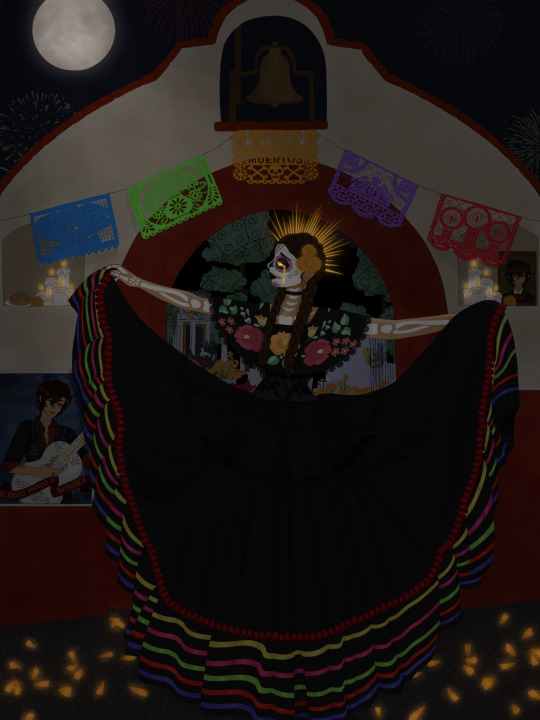
New art of skeleton mom finally 🧡 honestly one of my favorite pieces of art I've done
#twst oc#twisted wonderland oc#oc#twstoc#twst ocs#twst#twisted wonderland#twst staff oc#catrina maravilla#twisted wonderland ocs#twisted oc#la llorona#dia de los muertos#dia de los muertos oc art#even tho its late 🙃#Dante Maravilla#Emiliano Posada#if anyone wants theres a bunch of details i will happily ramble about-
84 notes
·
View notes
Text
OC Ship Headcanons: Dominic/Emiliano (Replacement AU)

TRIGGER WARNINGS: Mentions of abuse (physical/verbal/mental), gaslighting, rape/sexual assault, ED (unspecified, but can be theorised as anorexia or bulimia), cheating
Note: Normally I would post something this heavy on my nsfw blog but I do not trust minors on this site + this involves someone else’s oc. So. Just know that normally I don’t post stuff this in depth
Headcanons below the cut, Emiliano belongs to Lizz @thetwstwildcard
Context: Dominic doesn’t have that much memory of Catrina after her divorce from Emiliano since he was a college student at the time and often drunk or hangover. Also lost contact after she married (he was in NRC at the time). Therefore he didn’t know Emiliano was Catrina’s (ex-)husband
Was picked up by Emiliano at a bar and became a regular fuck buddy since drunk Dominic was easy to take advantage of, it began as an affair that continued on after the divorce
Dominic was basically a cheaper, easier replacement for Catrina since Emiliano was going to work at NRC as a professor. He didn’t offer much but between his love for drinking and personal image issues he was vulnerable enough to keep as a “mistress”
Re: the above two points; the relationship became an actual thing after the divorce vs just being a casual coincidental fuck buddy thing as revenge on Mozus regarding Catrina
Emiliano probably found out on accident after the divorce, maybe some offhanded drunken comment by Dominic
He moved into an apartment for convenience sake which sort of backfired since Trein wouldn’t see him often and thus wouldn’t know about the physical abuse at Emiliano’s hands, especially since Emiliano’s maids would swing by the morning after to heal any damage done
Symbolism: There’s nothing of Emiliano’s in Dominic’s apartment; possible gaslighting of they were never in a true relationship and that it was just Dominic one-sidedly projecting his own feelings onto Emiliano. (Not a shared living space for both but more like a hotel room for Emiliano)
Dominic never lived with Emiliano since he was just a fling, he never even made headlines since he was Trein’s son and would raise alarms if his face and name ever made the papers. Emiliano made sure any evidence of him going to Dominic’s place was taken care of, which had the added benefit of adding to the gaslighting of Dominic cause it became more difficult to prove the connection between them should he come forward.
I’d imagine Dominic develops an ED as a result of his pre-existing low self esteem/inferiority complex made worse by Emiliano’s verbal/mental abuse
Dominic becomes unhealthily perfectionistic since he has nothing to offer Emiliano aside from his body (not being interested in the arts including music vs Catrina’s composing), so the least he can do is try and do everything else well
Ironically Dominic trying to hard to appear laid back like he used to be whilst having developed an unhealthy level of perfectionism as well as an ED is what raises Mozus’s suspicions, especially when Dominic doesn’t seem to have touched any whiskey—his favourite—at staff drinking parties
#twst#twisted wonderland#twst oc#twisted wonderland oc#dominic trein#emiliano posada#replacement au#oc ship headcanons#oc ship hcs#ship hcs#tw: abuse#tw: violence#tw: rape#tw: sa#tw: ed#tw: physical abuse#tw: gaslighting#tw: manipulation#tw: mentions of abuse#tw: mention of sa#tw: mentions of violence#i hope the tags cover everything LMAO
1 note
·
View note
Text

José Guadalupe Posada La Gran Calavera de Emiliano Zapata (The Great Skeleton of Emiliano Zapata) c. 1911–1916, printed 1930 Photo-relief etching with engraving
MFAH
46 notes
·
View notes
Text
Con alegría disfrutaron Posada Navideña con Carlos Peña Ortiz en la Emiliano Zapata de Reynosa

Una Posada Navideña festejó el Alcalde Carlos Peña Ortiz por medio de la Secretaria de Bienestar Social, con una visita a los niños y familias de la colonia Emiliano Zapata, para convivir en estas fiestas decembrinas, con piñatas y regalos. "Convivimos con las familias de la colonia Emiliano Zapata, entregando regalos a los más pequeños, dulces, pastel y el payaso no pudo faltar; desde el Gobierno Municipal de Reynosa enviamos un mensaje a todos los reynosenses con el deseo de que tengan una Feliz Navidad", declaró el Alcalde al felicitar los asistentes. La convivencia familiar que encabezó el Presidente Municipal permitió que los menores pudieran disfrutar de sorpresas, regalos, show infantil, dulces y pastel, propios de la temporada en que se busca comunicar paz y alegría. #JuntosVolamosMásAlto Read the full article
0 notes
Text
Invitan a firma de autógrafos del "Chiringas" en Aguascalientes
Chicos y grandes podrán convivir con el joven charro, leyenda del deporte nacional. 08/08/23 | Emiliano Jiménez Otro buen atractivo en este XXX Campeonato Nacional Charro Infantil, Juvenil y Escaramuzas Aguascalientes 2023 “Maestro José Guadalupe Posada”, que ve caer las últimas páginas del calendario de competencias, será este miércoles a las 18:00 horas en la Arena San Marcos, con la firma de…

View On WordPress
0 notes
Text
Felicitaciones a la nueva profesional...el señor Kakubur Emiliano...quien expuso su tesis de Profesional Pastelero frente al director José y el profesor César...cursó sus estudios en la filial Posadas...
hace como él ...vení a estudiar con nosotros...te estamos esperando...
🗣️ INSCRIPCIONES ABIERTAS🔈🔊
CICLO 2023‼️‼️
QUE ESTÁS ESPERANDO PARA HACER REALIDAD TU SUEÑO
☑️ Uniformes, materiales de estudio e insumos incluidos....
📌 Chef internacional 👨🍳👩🏻🍳
📌 Profesional pastelero👩🍳🧑🏻🍳
📌 Gastronomía vegana 🥬🥦🥑
☑️ Cursos cortos
Abc panadero🍞🥖
Abc chef 🍜
Abc pastelero 🥧
Barman🍸🥃
Mozo/camarero
Certificación Internacional;
posibilidades de gestionar la titulación con la Universidad de Flores
ahora podrás participar del convenio de intercambio de alumnos con Sicilia Italia y cumplir tu sueño.
✅¡Consulta por la filial más próxima!
⚠️IGIOBERA
Av Andresito 1012. Oberá/Mnes.
📲Https://wa.me/3755346911
⚠️IGIPOSADAS
📲wa.me/3765225161
Felix de Azara 1236. Posadas/Mnes.
#igi #igiposadas #igiobera #institutogastronomicointernacional
#escueladecocina #chef #pastelero #panadero #cursos #talleres #capacitación #estudiar #carreragastronomica #ABCpanadero #ABCpastelero #ABCchef #chefinternacional #masterchef #maestropastelero #profesionalgastronomico #Barman #Tragos #CICLO2023 #promoción #precioscongelados

0 notes
Text

La Gran Calavera de Emiliano Zapata – José Guadalupe Posada – c. 1911-1916
19 notes
·
View notes
Photo
CATRINA 😂 😂 😂
This is how I see them ‘mourning’ in private:


Theo and Catrina: No, no, we’re sad. It’s a tragedy. A real tragedy (that it didn’t happen sooner).


I’m sorry @thetwstwildcard. I just had to do it.
Theo, later, when he is asked why he did that: I was throwing the peace sign. You know, like in ‘rest in piece-’ I mean ‘peace’. Of course.
34 notes
·
View notes
Text
Pedido de oración por Ludmila, Isabella, Luis y Marcela
Pedido de oración por Ludmila, Isabella, Luis y Marcela
Te comparto un pedido de oración urgente, que se prolongará por un tiempo: este 7 de enero de 2021 falleció Juan Di Filippo (en la foto superior), esposo de Ludmila Heinzmann, padre de Isabella (en la foto), y uno de los siete hijos de mis amigos Luis María Di Filippo y Marcela Granado. Mi pedido de oración es por ellos. Continue reading

View On WordPress
#Bianca Di Filippo#Buenos Aires#COVID-19#Emiliano Di Filippo#Facebook#Facundo Di Filippo#Federico Di Filippo#Francisco Di Filippo#hospital Posadas#Isabella Di Filippo#Juan Di Filippo#Ludmila Heinzmann#Luis María Di Filippo#María#María Dergarabedian#María Di Filippo#Marcela Granado#Oración#Pedido#Puerto Madryn#Trelew#Whatsapp
0 notes
Photo

The Great Calavera of Emiliano Zapata, José Guadalupe Posada
61 notes
·
View notes
Text
Local bastard (Catrina's ex husband) gets a revamp-

20 notes
·
View notes
Note
Oo reverse of your ask for contacts (Stef/Gian towards Cat Harem and Dominic towards my staff[give or take grumpy cat aka Valdis])?
Thanks for the ask! :3c
Stefano Fuoco
Catherine: Catherine Shire -> Cat 💕
Chase: Chase Shard -> Chase💜
Alice: Alice Pinka -> Alice 💙
Faline: Faline -> Faline💚
Gian Sidhe
Catherine: Catherine -> Cat nee-san
Chase: Chase -> Chase-aniki
Alice: Alice -> Alice nee-chan
Faline: Faline -> Faline nee-san
Dominic Trein
Catrina: sun goddess (not kin)
Sarafina: grrrr rawr xD
Lucien: pomey poetry fucker -> romeo but better/shakespeare but 🔥hot🔥
Emiliano: TDDD (tone deaf delusional duck)
Elysia: elyyyyy
Valdis: cat, i’m a kitty cat
#twst#twisted wonderland#twst oc#twisted wonderland oc#oc ask meme#stefano fuoco#gian sidhe#dominic trein#catherine shire#chase shard#alice pinka#faline#catrina maravilla#sarafina abara#lucien donadieu#emiliano posada#elysia di siena#valdis#thetwstwildcard#i have no idea what faline’s full name is but stef puts in full names at first
8 notes
·
View notes
Photo

The Dad Character of the Day is:
Emiliano Suarez from El Tigre: The Adventures of Manny Rivera
#Dad Character of the Day#Emiliano Suarez#El Tigre#el tigre: the adventures of manny rivera#He kind of reminds me of General Posada from The Book of Life
47 notes
·
View notes
Text
La Virgen de Guadalupe - Image of a Religious Icon
La Virgen de Guadalupe's image has become a symbol of identity for centuries in Mexico and the entire Western Hemisphere representing freedom, unity, economic value, and individual expression.

Her apparition on a hilltop near present day Mexico City in the 16th century began with a small circle of believers and through the centuries has expanded to millions globally. When she identified herself as the Virgin Mary the mother of God, she asked for a church to be built at the site in her honor. As been told for hundreds of years, when native Juan Diego opened his tilma (cloak) before archbishop Juan de Zumárraga in the winter of 1531, Castilian Roses fell to the floor as the tilma revealed her image for all to see, proving his encounter. Scholars and theologians disagree on her initial appearance and the reasons behind her epochal status. One thing they can agree on is how popular culture continues to view la Virgen de Guadalupe’s image as a central source for Resistance, Social Cohesion, Commercial Value, and Artistic Expression.
As la Virgen de Guadalupe’s apparition gained recognition throughout Mexico and the Americas, her image began to be recognized more than a religious symbol, it had evolved into an image that united and gave strength to the masses for the common goal of freedom from oppression.

In Juan O'Gorman’s mural ‘Grito de Dolores,’ Father Miguel Hidalgo promotes her image as the patroness of the revolt led during Mexican Independence from Spain in 1810.

The use of a banner with her image attracted the masses from all over Mexico to join the struggle for independence.

The rebels official banner is currently housed in Mexico's Museo Nacional de Historia at Chapultepec Castle, Mexico City.
In the early twentieth century her image appeared on banners as Emiliano Zapata’s peasant rebels entered Mexico City during the Mexican Revolution with the battle cry that included, “viva la Virgen de Guadalupe.”

Zapatistas march in front of the Palacio Nacional, Mexico City (December 6, 1914).

The use of her image soon became a source for social cohesion, uniting people in peace and devotion throughout the Americas for centuries. Annual festivities bring hundreds of thousands of her followers together to celebrate her appearance, marking December 12th an official holiday in Mexico and an official religious holiday globally.

All written narrations about the apparitions of la Virgen de Guadalupe are inspired by the ‘Nican Mopohua,’ written in the native Nahuatl language. Thanks in part to the ‘Nican Mopohua,’ the story and image of la Virgen de Guadalupe has spread throughout Mexico and the world for centuries.

Mexican political print-maker and engraver, José Guadalupe Posada, created the above flyer in 1895 for an academic seminar titled, “Colloquium to Celebrate the Apparitions of la Virgen de Guadalupe.”
Thousands of people from all over the world make the yearly pilgrimage to the Basílica de Nuestra Señora de Guadalupe, near Mexico City, to glorify Juan Diego’s original tilma and celebrate her apparition. Gathered together honoring her in prayer and song.




The commercial gain associated with the use of her image can be explained by the power and influence la Virgen de Guadalupe’s image has achieved throughout the centuries. Her image has been duplicated and transferred to sell household items, clothing and used as advertisements for goods and services.



In the Boyle Heights neighborhood of Los Angeles, merchants believe they have not been vandalized due to having her image decorating their establishments. The use of her image on walls and storefronts in public spaces is believed to help businesses in cities throughout the Americas with a high population of Catholic Latino followers.


The image of la Virgen de Guadalupe has inspired and influenced artists to call out the continued struggle for racial and social equality in the United States. Artist have taken the liberty of combining the image of la Virgen de Guadalupe with ongoing injustices facing Latino communities.

“Our Lady of Guadalupe” by Yolanda Lopez (1978)

“Superwonder Lupana” by Israel Rico (2009)

“Unholy Escort” by Katie Jo Suddaby (2019)

“La Virgen de Guadalupe” BrownPride.com (2009)
Although the image of la Virgen de Guadalupe continues to inspire people for many reasons, the main motive continues to be ultimate devotion to her and the self empowerment her image conveys. She is seen as the focal point on large wall murals, body tattoos on men and women, and countless personal objects for all to see. Proving that her image continues to be a point of pride and allegiance for millions.



When la Virgen de Guadalupe appeared to Juan Diego in the Winter of 1531, Diego did not believe who she was and why she was asking for his help. Little did he know that her apparition and image would propel her in becoming one of the most recognizable and utilized religious figures throughout the Americas 500 years later.
4 notes
·
View notes
Text
Andrés Mora a la final de charros completos infantiles “A”
El joven michoacano logró agónico pase a la última instancia con 198 puntos. Ultíma actualización: 31/07/23 12:36 pm | Emiliano Jiménez Concluyeron las rondas eliminatorias de la categoría Infantil “A” varonil, dentro del XXX Campeonato Nacional Charro Infantil, Juvenil y de Escaramuzas Aguascalientes 2023 “Maestro José Guadalupe Posada”, que ha consumado su primera semana de actividades en la…

View On WordPress
#Campeonato Nacional Charro Infantil#Charrería#Federación Mexicana de Charrería#Lienzo Charro#Torneo Charro
0 notes
Text
References to Mexican Culture in Coco
By now, you’ve probably heard Coco is one of the most well researched films about Mexico and its culture. There are many small details that make it feel like Mexico: the stone roads in a small town, the traditional embroidery patterns in the shirts of Miguel’s female relatives, an uncle wearing a soccer team shirt, even a bowl of limes in a stand of aguas frescas. Of course, the looks of papel picado, day of the dead altars, and cemeteries are also well represented. The clothes of the relatives Miguel sees in the world of the dead is accurate to their eras. While these are a nice touch, you’re ultimately not missing out on anything by not spotting them, so in this post I wanted to talk about the more culturally based details that show the most research and you might not understand if you’re not very well acquainted with Mexican culture:
Names and pronouns
1. Coco
This one is the most straightforward, so let’s start with the name of the movie. While the protagonist is called Miguel, we soon learn that Coco is his great grandmother. “Coco” is what we call a woman called “Socorro” (lit. “help” - it’s a very traditional name that’s considered old fashioned).
The Rivera family calls her “Mamá Coco,” which means “Mother Coco.” They also call Imelda “Mamá Imelda,” and so on. Calling your grandparents “mamá” or “papá” instead of “abuelita” and “abuelito” is a thing you can do, though I can’t say how common it is.
In the Spanish version of the film, Miguel’s grandmother, Elena, talks to Mamá Coco with “usted” (I didn’t notice other instances, but they might be there). Spanish has a formal and an informal version of singular “you:” “usted” for formal, “tú” for informal. The verb conjugation also changes depending on which one you use. It is used differently all through the Spanish speaking world, but in Mexico, other than older people you respect (like a teacher), you can talk to older family members with “usted,” which means respect rather than the distance the formality might imply. Nowadays, it has fallen out of use: as someone born in the 90s, my grandparents talked to their parents almost exclusively with “usted;” out of my parents, my mother talked to hers with “usted” and my father with “tú;” I speak to my parents with “tú.” I have cousins on my mother’s side that talk to their parents with “usted,” but I would say that makes them a minority nowadays.
Traditions and beliefs
2. Crossing to the world of the dead on a bridge of marigolds
If you paid very close attention, you might have noticed two children scattering marigold petals on the ground and their mother telling them not to scatter them, but to make a bridge so the dead could cross over. It was easy to miss, but that’s actually something we believe!
There are several types of flowers you can place in a day of the dead altar, but the one you can’t do without is the yellow marigold. Its petals are scattered all around the altar, and at the very front, you’ll form a path surrounded with candles. The bright yellow will help the dead properly make their way to the altar, and the candles surrounding the path will light their way.

3. Crossing to the world of the dead with a xoloitzcuintli
Several prehispanic cultures had a similar concept of the underworld as many other cultures around the world, in which there was a river they had to cross to get there. For both the Aztecs/Mexicas and the Mayas, a xoloitzcuintli would guide their souls so they could cross the river safely and arrive to Mictlan (Mexicas) or Xibalba (Mayas). To achieve this, a xoloitzcuintli would be sacrificed and buried with its owner. Day of the dead altars can have a xoloitzcuintli figure so that the dead can make it back safely as well.

4. Being thrown into a cenote
My screenshot isn’t the best but at some point, Miguel is thrown into a big pit with water. That’s not just any random pit, but a cenote.
Cenotes are naturally ocurring sinkholes caused by the collapse of limestone. The word “cenote” has Maya etymology, as cenotes are commonly found in the Yucatán peninsula, where they (still!) live. In old times, they would sacrifice animals and people as tributes to the gods, and also throw ceramic objects and jewelry as part of the tribute.

5. Alebrijes
I left these for last because they don’t have any deep meaning. Alebrijes are colorful fantastic animals that a man called Pedro Linares saw in a fever dream. He was a skilled artisan, so when he woke up from his long sickness, he brought them to life in his art.
In Coco, alebrijes are spiritual guides, and while their designs are to the likes of the real alebrijes, the film actually gave them a more important role than they have for us.
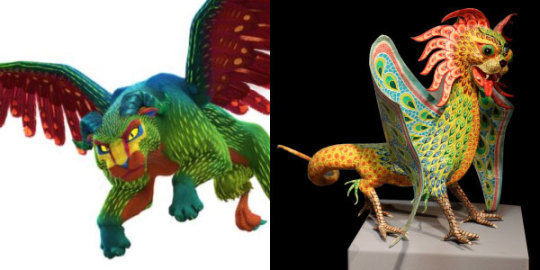
Music
6. Genres of Mexican music
The songs in Coco all belong to genres we’ve grown up with, so even if someone isn’t that knowledgeable in music theory or genres, we could vaguely tell they sounded “Mexican” (some more than others). Someone who is more knowledgeable of music genres can help me out here, but I think:
- Remember Me / Recuérdame is a bolero ranchero.
- Much Needed Advice / Dueto a través del tiempo is a ranchera.
- Everyone Knows Juanita / Juanita is a corrido.
- Un Poco Loco is a son jarocho.
- The World Es Mi Familia / El mundo es mi familia is huapango inspired.
- Proud Corazón / El latido de mi corazón is a a son (son de mariachi? I’m most uncertain about this one).
6.5 Un Poco Loco
Un Poco Loco starts in English as
What color is the sky, ay mi amor, ay mi amor, You tell me that it’s red, ay mi amor, ay mi amor
And in Spanish as
Que el cielo no es azul, ay mi amor, ay mi amor, Es rojo dices tú, ay mi amor, ay mi amor
(You say the sky isn’t blue, oh my love, oh my love, It’s red, you say, oh my love, oh my love)
This might be a deliberate reference to a huapango called “Cielo rojo,” which says:
Mientras yo estoy dormido Sueño que vamos los dos muy juntos A un cielo azul Pero cuando despierto El cielo es rojo, me faltas tú
(As I sleep I dream of us close together Going towards a blue sky But when I wake up The sky red, I am missing you)
Within the universe of the movie, this would make it an anachronistic reference, though. Additionally, Cielo rojo is a song of loss and Un poco loco is about a woman who thinks very differently and likes to say everything backwards, and that makes him crazy (in a good way!). Hence, in English we’ve got her saying to put his shoes on his head instead of his feet, and in Spanish him saying she might think with her feet and also how she keeps playing with his thoughts. Cielo rojo is a pretty sad song.
7. La Llorona
And I purposefully left La Llorona out of that list (it’s originally a son istmeño, though).
There’s a full musical number in Spanish, which seems to have suprised some people. For those of us who watched Coco in Spanish, it wasn’t too hard to guess it was this one: La Llorona was likely left in Spanish because it’s a very old folk song, one of those that are so old it has no known author and there are many different versions of the lyrics.
“Llorona” just means “weeper,” which is not really as unusual of a word in Spanish as it is in English. It’s closer to “crybaby” in use. She’s also what we call a character in a Mexican folktale. If you’re curious, the version used in Coco says the following, with “llorona” being the singer herself:
Poor me, llorona, llorona dressed in sky blue Even if it costs me my life, llorona, I won’t stop loving you I climbed the highest pine tree to see if I could spot you Since the pine tree was so green, llorona, it cried upon seeing me cry
What is grief and what is not grief, llorona: it all is grief to me Yesterday, I was crying to see you, llorona; today, I’m crying because I saw you
Poor me, llorona, llorona dressed in sky blue Even if it costs me my life, llorona, I won’t stop loving you
Famous people
8. Ernesto de la Cruz
“Isn’t he an original charact-” NO LISTEN STAY WITH ME.
Remember how I said Remember Me is a bolero ranchero? Guess who we associate boleros rancheros with?

That would be Pedro Infante, who happens to have a strong resemblance to no other than Ernesto de la Cruz.
It’s probably not a coincidence at all, as later on we see Ernesto with Pedro Infante and Jorge Negrete at his party. Ernesto de la Cruz was explicitly stated to be inspired on both of them and another singer of the same genres, Vicente Fernández.
My parents left the movie saying “Pedro Infante didn’t deserve that burn,” lol.
9. Frida Kahlo (and Diego)
She does have a rather prominent role so she’s hard to miss. For those unaware, Frida is the artist who made the flaming papaya.
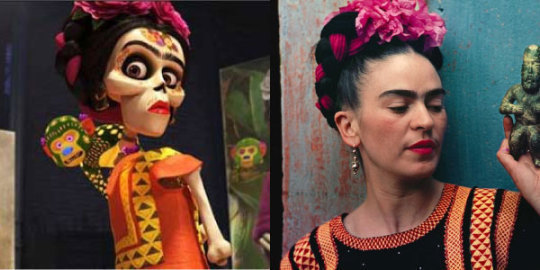
The themes in Frida’s are autobiographical, as she had a rather unusual life due to polio and injury. She painted herself and her suffering a lot. That might be why we get performances with many Fridas and things like a crying cactus that’s herself.
Bonus: her husband, Diego Rivera, is also in the same studio where we meet Frida. He was an important artist, specifically a muralist.

10. Other Mexican celebrities
I already brought up Pedro Infante and Jorge Negrete as characters that appear right beside Ernesto de la Cruz.
But we also get to see a cameo of many other famous Mexican names in Ernesto’s studio! Excluding the people at the piano, from left to right:
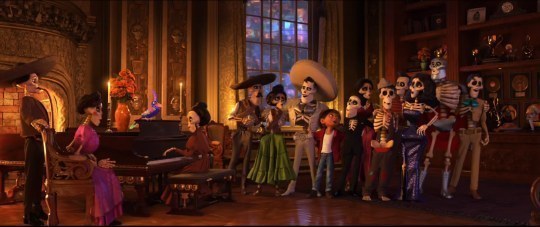
Emiliano Zapata, a revolutionary; (my best guess is) Adela Velarde, another revolutionary; Ernesto and Miguel; (probably) Agustín Lara, composer and singer; (probably) Dolores del Río, actress (in Hollywood too!); Cantinflas, comedian and actor; Pedro Infante, singer and actor; María Félix, actress; El Santo, wrestler and actor; Jorge Negrete, singer and actor.
They kind of looked like this:

Another bonus: this gal looks like the calavera garbancera / the Catrina illustrated by José Guadalupe Posada.
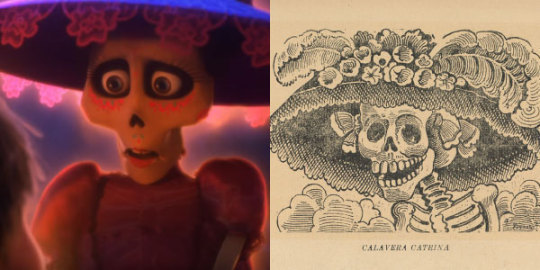
There might be more things I’m missing or forgot; if that’s the case, feel free to let me know! You can also fix my music genres for me since that’s never been my forte.
I hope this was of interest to someone!
17K notes
·
View notes